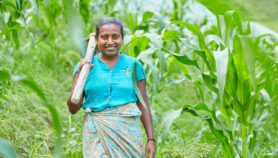Send to a friend
The details you provide on this page will not be used to send unsolicited email, and will not be sold to a 3rd party. See privacy policy.
[ANTANANARIVO] Researchers in Madagascar have spotted early warning signals on locusts that could indicate when they are about to swarm.
Reading a series of colour changes that correspond with increasing densities of the red locust (Nomadacris septemfasciata) — which is a threat to rice-growing zones — could lead to better control measures, they report.
It is already known that red locusts change colour when they form swarms. Now, scientists at the Center for International Cooperation in Agronomic Research for Development (CIRAD) have identified what they say is the first sign of swarm-forming behaviour.
The team studied the colour of more than 1,000 red locusts in southwestern Madagascar. They found that a slight black spot appears on the femur at the first sign of gregarisation (when their density rises to ten hoppers per square metre). Once there are 30 hoppers per square metre, the head turns a reddish-orange colour and the first segment of the insect turns yellow.
By the time there are more than 100 hoppers per square metre, the entire body has turned bright orange, the yellow colour of the first thoracic segment is more yellow and the black patches are darker.
"The study could enable the National Anti-Locust Centre (CNA) to characterise the developmental stages of locust swarms and understand their harmfulness," Michel Lecoq, lead author of the study, published in Psyche, and a researcher at CIRAD, told SciDev.Net.
Locust swarms remain a concern in northwest and southwest Madagascar, despite years of field interventions, according to Jocelyn Rajaonarison, an entomologist at the National Centre of Applied Research for Rural Development (FOFIFA), based in Antananarivo.
"Locusts are harmless when solitary. However, we face a big issue once they become gregarious," said Rajaonarison.
Lecoq said collecting information on the colour change and density of locust populations, as well as local rainfall patterns and the state of vegetation, is key to preventing migratory locust plagues on the island.
"Until now, the criteria used were unclear, making surveillance and prevention approaches less effective," he added.
New strategies for controlling locust swarms in Madagascar could also be applied in central and southern Africa, where the red locust strikes from time to time, according to the researchers.













